The Turing machine (and thus, the computer) resembles the generalized semiotic structure. It consists of the conjunction of two series inside of a container. One series is made up of states out of a set of finite possibilities, the order of which proceeds by means of a determinate set of rules. The other is a series of symbols arranged in time along a potentially infinite ribbon of inscription, where the value of the symbols is dependent on their order. The machine is a conjunctive emptiness, which produces in movement.
Figure 1 
Empty Square | The Empty SquareGilles Deleuze writes in The Logic of Sense that, “there is no structure without the empty square, which makes everything function.” This particular figure of absence, the “container object,” underwrites a substitutional strategy wherein one instance of its content is replaced by another within a serial chain . The idea of containment is transformed into a vehicle for traversal; emptiness is made to work as a machine. | |
Figure 2a 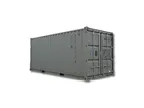
Container (Shipping) | Container ObjectThe container is a trope that George Lakoff would call an ontological metaphor. It refers to our experience of objects in the world and ultimately to the experience of the body as a discrete object–as a bounded entity with a surface that distinguishes the inside from the outside. | |
Figure 2b 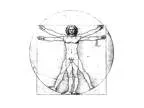
Container (Vitruvian) | “Human purposes,” writes Lakoff, “typically require us to impose artificial boundaries that make physical phenomena discrete just as we are.” The container has the status of metaphor and its deployment is an imposition, a projection which is the concomitant of an instrumentalizing gesture. | |
A Figure 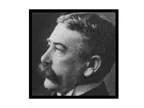
Ferdinand de Saussure (1857-1913) | Saussure – SignificationSaussure’s General Linguistics gives us “the sign” as a structure in which the notion of the arbitrary serves as a kind of emptiness. | |
Figure 3a 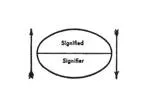
Sign (Source: Course in General Linguistics, pg. 114) | The sign is drawn as an ellipse divided by a horizontal line. The sign is a container with two compartments; the line indicates the principal of arbitrariness, which connects the two. | |
Figure 3b 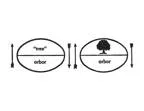
Figural Substitutions (Source: Course in General Linguistics, pg. 66) | The container function of the ellipse is demonstrated in the text through the multiplicity of examples where the compartments of the sign figure are filled variously. | |
Figure 3 
Dimorphic Arbitrariness | We can imagine that the line, by curving to encircle one term or the other, might enable each to be considered the container of the other. A given signifier is linked to any number of signifieds. The line of the arbitrary forces one item to the surface and empties the center to serve as a conduit for substitutions. | |
Figure 3d 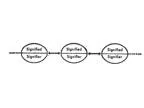
Relations of Signs (Source: Course in General Linguistics, pg. 115) | For the sign, a link is a substitution: a signifier substitutes for the signified. Signs also form chains of relations to other signs, which they may replace. Language is characterized by a generalized theory of value wherein both similar and dissimilar things are systematically exchanged for each other. | |
Figure 3e 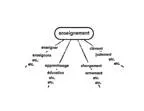
Associative Relations (Source: Course in General Linguistics, pg. 126) | In the syntagmatic dimension, consecutive elements succeed one another in time and acquire value in relation to what proceeds or follows. In the paradigmatic dimension, terms are related in absence, outside of discourse, in memory, or in virtuality. Saussure’s diagram of the associative relation shows a word inside a container, with multiple series of words diverging from it. The lozenge indicates that which is inside and present at a given moment, as it exists in relation to the absent series. Given the inevitability of ejection from the present, being inside only attains value by virtue of that which is outside. The container marks out the here and the now as a spatial impossibility: a nowhere. It is the target of intersecting trajectories of presence along temporal and virtual planes that make use of the spatial as metaphor, a “place-holder” which keeps it open and keeps it moving. | |
A Figure 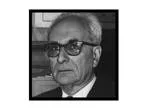
Claude Lévi-Strauss (1908-) | Lévi-Strauss – MythLévi-Strauss transforms Saussure’s linguistic structures by applying them to myth. | |
Figure 4a Fa(x) : Fa(x) :: Fa(x) : Fa(x) Algebraic Diagram | He employs an algebraic diagram read, “the x function of a is to the y function of b as the y function of x is to the inverse a function of b”. Myth is the transformation and circulation of these analogies. Lévi-Strauss writes, “Every myth confronts a problem, and it deals with it by showing that it is analogous to other problems … A solution that is not a real solution to a specific problem is a way of relieving intellectual uneasiness ... ” Lévi-Strauss makes of myth a system of equations in which the symbols and their relations produce an illusion that the equations are solvable. But the possible solutions, the possible transformations, are endless. The structure of myth is like the sign, in that they both form a series of double containers. Each item is subject to replacement independent of the complimentary term on the other side of either the single or double colon. The presence of terms in any of the spaces within the formula is tentative, with the result that abandoned terms demand a supplement: they become empty. This structure introduces a notion of rule. A mythic symbol must be equivalent to its related term in some particular way. The grounds of equivalence are factored through the concept of function. The particular sense of a term, as established by function, acts as a constraint for subsequent relations. These relations, like the associational links within Saussure’s logic, create chains of connections along trajectories determined by a functional typology. | |
Figure 4c 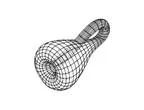
Klein Bottle | In The Jealous Potter, Lévi-Strauss treats an especially widespread American mythic theme which takes the shape of a Klein bottle, the topographical figure which like the möbius band has only a single surface, and for which there is no distinction between the inside and the outside. Typically, a three-stage transformation is related: “(1) the hero’s body enters a tube that contains him; (2) a tube formerly contained in the hero’s body emerges from it; (3) the hero’s body becomes a tube–something either goes in or comes out of it.” The various myths cycle through a combinatorics of possible container functions–of the body and of things–and circulate a problematics of undecidability: is it, am I, container or contained? | |
Figure 4d Fcontained(body) : Fcontainer(tube) :: Fcontained(tube) : Fbody-1(container) Algebraic Diagram Contain(er|ed) | The undecidability of containment applies to the algebraic formulation of myth, where each term is contained within a structure, and any term may be replaced. Every term is a place holder–an emptiness to be filled–as much as an object in a place. The expectation of completion sets in motion a serial cascade of attempted closures by rule of function, as each term slips from contained to container. | |
A Figure 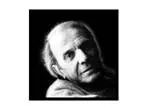
Gilles Deleuze (1925-1995 ) | Deleuze – aleatory point, thought/creationIn The Logic of Sense, Deleuze transforms structure in the service of thought. Again, “two heterogeneous series converge toward a paradoxical element which is their ‘differentiator.’ ... This element belongs to no series; or rather, it belongs to both series at once and never ceases to circulate throughout them.” In the architecture of thought, which he maps, a problem is defined in terms of a set of possible solutions, organized as singular points that converge. Multiple series are traversed by the “aleatory point,” which contains points in the series as events. The problem is a kind of constraint inferred from the range of solutions. The question is determined in relation to an endless stream of events, possible answers, which spontaneously succeed one another within the aleatory point. Problems remain without solutions and questions without answers in that the multiplicity of successive events serves only to determine problems, and the enveloping fundamental question, without suppressing subsequent solutions and answers. | |
Figure 5a a·( b + c ) = a·b + a·c True for all real numbers a b c Distributive Theorem | Turing – Machine, ComputationIn mathematics, the question of decidability rests on whether there exists a method by which it is possible to determine if a proposition is provable. Where there are infinitely many instances, how can we grasp the truth by a finite method? In language, at any given moment, there is a finite set of signifiers in the store from which a description of an infinite existence, or an infinity of possible expressions might be formed. So the question, phrased as, “how to specify the infinite in finite terms,” is one shared by both mathematics and linguistics. | |
A Figure 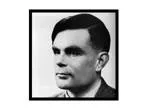
Alan Turing (1912-1954) | Alan Turing transforms this question by asking it in the register of computability: “what does it mean to specify a method for calculating the potentially infinite digits of a real number, for example π?” The problem of decidability becomes a subspecies of the question of computability, and the idea of computability is inaugurated as the machinic reduction of human intelligence. A computer had been a person employed to make calculations. Turing, by making the computer finite, converts it into a machine. After saying that the computer is like a machine, “We may now construct a machine to do the work of this computer.” | |
Figure 5b 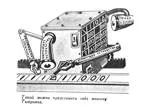
Turing Machine, Anthropomorphic (Source: Turing Archive, Modern Archives Centre at King's College, Cambridge www.turingarchive.org) | Turing writes, “We may compare a man in the process of computing a real number to a machine which is only capable of a finite number of conditions ... which will be called ‘m-configurations’. The machine is supplied with a ‘tape’ ... divided into sections (called ‘squares’) each capable of bearing a ‘symbol’. At any moment there is just one square ... ‘in the machine’. The ‘scanned symbol’ is the only one of which the machine is, so to speak, ‘directly aware’...” | |
Figure 5c 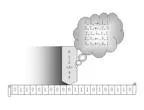
Turing Machine Schematic A (Source: digitalphysics.org/Publications/Petrov/Pet02a2/Pet02a2.htm) | The work of the machine is accomplished through carrying out one of three possible operations. It can erase or print a symbol on the scanned square, move one square to the left or right, and change its configuration. The rules, which govern what operation the machine carries out, are given in a table of behaviors, indexed by the configuration and symbol. In each moment of discreet time, the machine acts according the operation described for the encounter of the state it is in with the symbol that is in it. Turing demonstrates that π, along with many other real numbers, for which definite methods of calculation are known, can be computed using this machine. He also shows that there are some numbers, which can be described but not computed. | |
Figure 5d 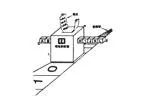
Turing Machine Schematic B (Source: episte.math.ntu.edu.tw/articles/sm/sm_30_11_2/page3.html) | The Turing machine resembles the generalized semiotic structure. It consists of the conjunction of two series inside of a container. One series is made up of states out of a set of finite possibilities, the order of which proceeds by means of a determinate set of rules. The other is a series of symbols arranged in time along a potentially infinite ribbon of inscription, where the value of the symbols is dependent on their order. The machine is a conjunctive emptiness, which produces in movement. It is teleologically bounded, since the rules of the table pre-determine the movement and the outcome on the tape, even if that product is an infinite series. In the machine, a relationship of supplementarity attains between state and symbol, as the state, through the operation of the table of behavior, requires the symbol and brings it to presence within itself. But the presence of the symbol in the machine, is what causes the evacuation of the machine, or the substitution of a new symbol. The machine is the play of presence and absence of a series of symbols according to a logic determined in the table. Or the table is the machine as a surface that constitutes the particularized logic of its own habitation by symbol and state. | |
Figure 6 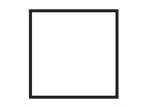
Empty Square | Status of the Container Object FigureThe empty square is both the emptiness of the square and the square’s positivity as a boundary function. Its emptiness is dependent on its boundedness; its boundedness on its emptiness. Conceiving of structure in terms of a container object, produces as a kind of byproduct a surface whose status is always problematic. The diagrammatic impulse entails the inclusion of elements, which amount to a surface. The appearance of these concomitants of containment, point towards the nature of structure through containment. The notion of a container, hinges on the status of the surface–inside or outside, present or not–which takes us again to the figure of the Klein bottle. The surface of containment is undecidable; it has the paradoxical status–as both container and contained–of the container itself, constituting the possibility of containing and the conditions of containment. Surface appears as an abstraction of the container function, and a side-effect of the alternation of presence and absence within a series–a conceptual placeholder for the conjunction of the here and the now. |
A PDF of this text is available for download: